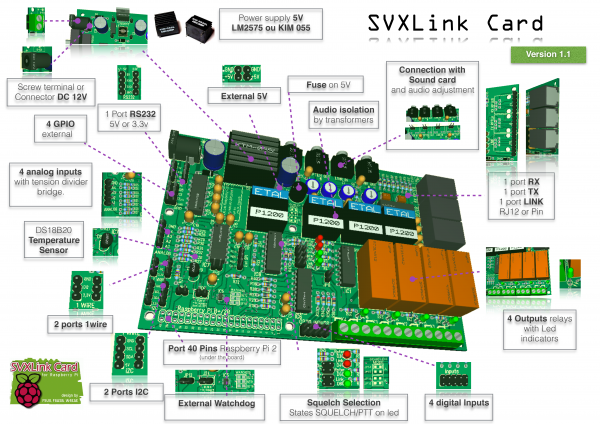 Cette page n'est pas encore traduite entièrement. Merci de terminer la traduction
Cette page n'est pas encore traduite entièrement. Merci de terminer la traduction
(supprimez ce paragraphe une fois la traduction terminée)
The characteristics of the card are the following
- Dimensions 150mm x 100mm
- External power supply 12 Volts, regulator on board 5 Volts for Raspberry Pi integer with LM2575 or KIM055
- 2 radio way repeater (RX and TX) and also one way to transponder or Link by radio
- Audio level ajustement with potentiometers (In/Out)
- Connections to transceivers by pin (Dupont) or by RJ12 connector (6P6C)
- Audio isolation by transformers
- Connect to USB audio cards by stereo audio Jack or pins (Dupont)
- LED Indicators for PTT and SQUELCH detection
- Normal or reverse SQUELCH detection selectable by jumper.
- 4 outputs on relays with LED indicators
- 4 digitals inputs
- Protection by opto isolated on digital Input and Output.
- 4 analogs inputs (0-3,3 Volts)
- 2 1WIRE ports, 1 temperature sensor DS1820 on board
- 1 RS232 port
- 2 I2C ports
- External Watchdog with ajustable timer set by solder jumpers.
- 40 pins connection for Raspberry Pi
The SVXLink Card board supplies the power to the Raspberry Pi thru the 40 pins connector. The recorded consumption of the board SVXLink Card are the following ; It's for a configuration with one USB soundcard (RX + TX):
- Standby : 150 mA / 12V (soit 1,8W)
- Transmitting : 200 mA / 12V (soit 2,4W)
- 4 relays switched : 350 mA /12V (soit 4,2W)
- Transmitting and 4 relays switched : 390 mA/ 12V (soit 4,7W)
Main Features
- Repeater controler with Raspberry Pi and SVXLink Software
- Squelch detection (Large voltage 2,2V to 12 V)
- Statuts leds indicators (Squelch, PTT)
- Isolated Audio interfaces with adjustable level for 3 way.
- External power supply between 9 and 12 Volts
Secondary fonctions, options
- 4 outputs relays switch 400Vac / 4kVA, with led indicator
- 4 inputs opto isoled
- 4 analogs inputs adjustable (with voltage divider)
- (or) 2 inputs for smeter (signal level receiver)
- Temperature sensor on board
- Protection against unexpected freeze (watchdog for reboot)
- Availability of bus 1-Wire (2 connections)
- Availability of bus SPI (Serial Peripheral Interface)
- Availability of bus I2C (2 connections)
- Availability of bus RS-232)
- Availability of 4 remaining GPIO availables on Raspberry Pi
Features of repeater
The installed software is SVXLink developed by a amateur radio ( SM0SVX). This software manage many functions. The SVXLink Card board uses these functions. The configuration of SVXLink is modified or completed to allow using the secondary features of the board:
- Power on repeater, by radio way (DTMF rolling code )
- Smeter from received radio stations
- Voices announcement of locals measurements
- Temperature of board environment
- Analogs inputs
- Status of digitals inputs
But why all this ?
Here are examples of applications:
- The temperature sensor mesures the repeater cabinet, it could very well activate a thermal resistance to maintain the cavities at good temperature. And transmitting with voice the temperature.
- Possibility to change output repeater power in low power with switching relay.
- Possibility to switch off power supply to switch in battery mode.
- Analog input can mesure smeter but also for measuring the supply voltage or the battery voltage, a relay may then cutting battery power to preserve them.
- This will connect a LCD / GLCD screen, buttons on the I2C port, a real human/machine interface that will display the repeater states or events.
- Inputs digitals can indicate the 230V power supply or the door of the cabinet status.
- Repeater send by mail every evening a reporting of activity.
- A web page show measurement and status of inputs/outputs in realtime.
You'll understand the possibilities are great and belong to your imagination.
How SvxLink manages it all ?
It's very simple, it handles only the PTT and squelch detection switching and audio mixing. It also manages direct radio link or through echolink and voice synthesis.
For everything else it's us or you to code. The Linux world will allow all that, for example, repeater display will manage with a small program that will read the LOG file of SVXLink and display it on the screen.
All state variables or measures can be shared between applications. CRON can enable to schedule scenarios at time, for example sending repeater information an email every day at fixed time of the day.
